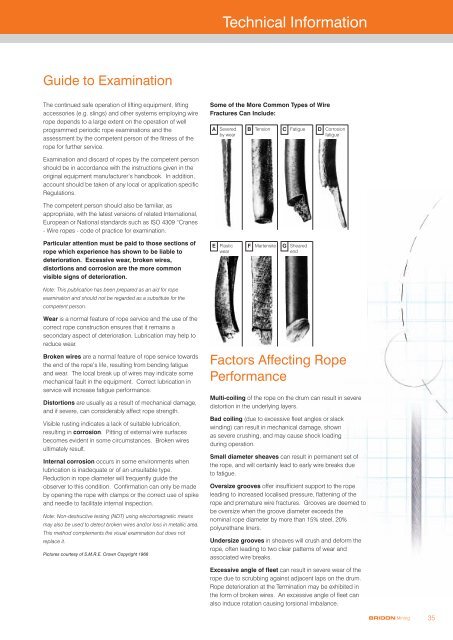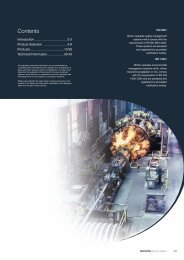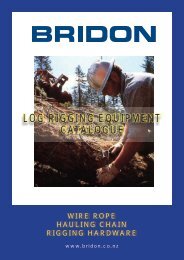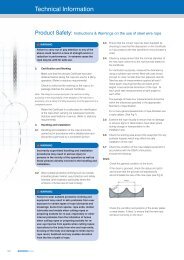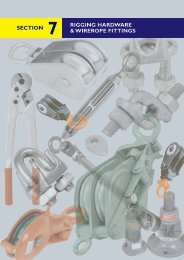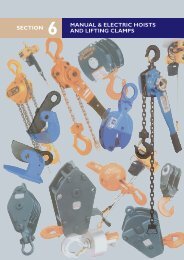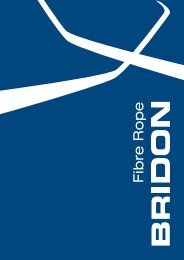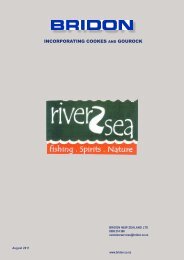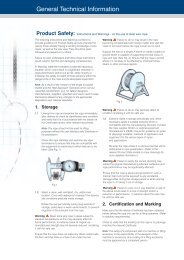Create successful ePaper yourself
Turn your PDF publications into a flip-book with our unique Google optimized e-Paper software.
Technical InformationGuide to ExaminationThe continued safe operation of lifting equipment, liftingaccessories (e.g. slings) and other systems employing wirerope depends to a large extent on the operation of wellprogrammed periodic rope examinations and theassessment by the competent person of the fitness of therope for further service.Some of the More Common Types of WireFractures Can Include:A Severedby wearB Tension C Fatigue D CorrosionfatigueExamination and discard of ropes by the competent personshould be in accordance with the instructions given in theoriginal equipment manufacturer’s handbook. In addition,account should be taken of any local or application specificRegulations.The competent person should also be familiar, asappropriate, with the latest versions of related International,European or National standards such as ISO 4309 “Cranes- Wire ropes - code of practice for examination.Particular attention must be paid to those sections ofrope which experience has shown to be liable todeterioration. Excessive wear, broken wires,distortions and corrosion are the more commonvisible signs of deterioration.Note: This publication has been prepared as an aid for ropeexamination and should not be regarded as a substitute for thecompetent person.E PlasticwearF Martensite G ShearedendWear is a normal feature of rope service and the use of thecorrect rope construction ensures that it remains asecondary aspect of deterioration. Lubrication may help toreduce wear.Broken wires are a normal feature of rope service towardsthe end of the rope’s life, resulting from bending fatigueand wear. The local break up of wires may indicate somemechanical fault in the equipment. Correct lubrication inservice will increase fatigue performance.Distortions are usually as a result of mechanical damage,and if severe, can considerably affect rope strength.Visible rusting indicates a lack of suitable lubrication,resulting in corrosion. Pitting of external wire surfacesbecomes evident in some circumstances. Broken wiresultimately result.Internal corrosion occurs in some environments whenlubrication is inadequate or of an unsuitable type.Reduction in rope diameter will frequently guide theobserver to this condition. Confirmation can only be madeby opening the rope with clamps or the correct use of spikeand needle to facilitate internal inspection.Note: Non-destructive testing (NDT) using electromagnetic meansmay also be used to detect broken wires and/or loss in metallic area.This method complements the visual examination but does notreplace it.Pictures courtesy of S.M.R.E. Crown Copyright 1966Factors Affecting RopePerformanceMulti-coiling of the rope on the drum can result in severedistortion in the underlying layers.Bad coiling (due to excessive fleet angles or slackwinding) can result in mechanical damage, shownas severe crushing, and may cause shock loadingduring operation.Small diameter sheaves can result in permanent set ofthe rope, and will certainly lead to early wire breaks dueto fatigue.Oversize grooves offer insufficient support to the ropeleading to increased localised pressure, flattening of therope and premature wire fractures. Grooves are deemed tobe oversize when the groove diameter exceeds thenominal rope diameter by more than 15% steel, 20%polyurethane liners.Undersize grooves in sheaves will crush and deform therope, often leading to two clear patterns of wear andassociated wire breaks.Excessive angle of fleet can result in severe wear of therope due to scrubbing against adjacent laps on the drum.Rope deterioration at the Termination may be exhibited inthe form of broken wires. An excessive angle of fleet canalso induce rotation causing torsional imbalance.BRIDON <strong>Mining</strong>35


